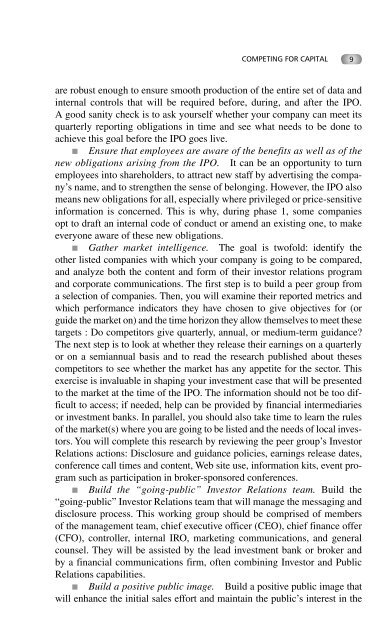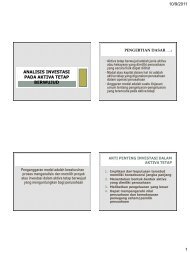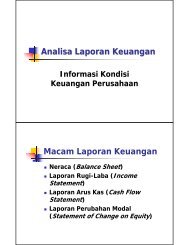Investor Relations
Investor Relations
Investor Relations
- No tags were found...
Create successful ePaper yourself
Turn your PDF publications into a flip-book with our unique Google optimized e-Paper software.
COMPETING FOR CAPITAL 9are robust enough to ensure smooth production of the entire set of data andinternal controls that will be required before, during, and after the IPO.A good sanity check is to ask yourself whether your company can meet itsquarterly reporting obligations in time and see what needs to be done toachieve this goal before the IPO goes live. Ensure that employees are aware of the benefits as well as of thenew obligations arising from the IPO. It can be an opportunity to turnemployees into shareholders, to attract new staff by advertising the company’sname, and to strengthen the sense of belonging. However, the IPO alsomeans new obligations for all, especially where privileged or price-sensitiveinformation is concerned. This is why, during phase 1, some companiesopt to draft an internal code of conduct or amend an existing one, to makeeveryone aware of these new obligations. Gather market intelligence. The goal is twofold: identify theother listed companies with which your company is going to be compared,and analyze both the content and form of their investor relations programand corporate communications. The first step is to build a peer group froma selection of companies. Then, you will examine their reported metrics andwhich performance indicators they have chosen to give objectives for (orguide the market on) and the time horizon they allow themselves to meet thesetargets : Do competitors give quarterly, annual, or medium-term guidance?The next step is to look at whether they release their earnings on a quarterlyor on a semiannual basis and to read the research published about thesescompetitors to see whether the market has any appetite for the sector. Thisexercise is invaluable in shaping your investment case that will be presentedto the market at the time of the IPO. The information should not be too difficultto access; if needed, help can be provided by financial intermediariesor investment banks. In parallel, you should also take time to learn the rulesof the market(s) where you are going to be listed and the needs of local investors.You will complete this research by reviewing the peer group’s <strong>Investor</strong><strong>Relations</strong> actions: Disclosure and guidance policies, earnings release dates,conference call times and content, Web site use, information kits, event programsuch as participation in broker-sponsored conferences. Build the “going-public” <strong>Investor</strong> <strong>Relations</strong> team. Build the“going-public” <strong>Investor</strong> <strong>Relations</strong> team that will manage the messaging anddisclosure process. This working group should be comprised of membersof the management team, chief executive officer (CEO), chief finance offer(CFO), controller, internal IRO, marketing communications, and generalcounsel. They will be assisted by the lead investment bank or broker andby a financial communications firm, often combining <strong>Investor</strong> and Public<strong>Relations</strong> capabilities. Build a positive public image. Build a positive public image thatwill enhance the initial sales effort and maintain the public’s interest in the











